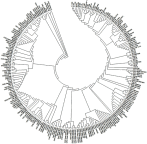Spoligotyping analysis of Mycobacterium tuberculosis in Khyber Pakhtunkhwa area, Pakistan
- PMID: 31190924
- PMCID: PMC6535427
- DOI: 10.2147/IDR.S198314
Spoligotyping analysis of Mycobacterium tuberculosis in Khyber Pakhtunkhwa area, Pakistan
Abstract
Background: Spoligotyping is a reproducible, reverse hybridization approach for genotyping of Mycobacterium tuberculosis complex (MTBC). Molecular typing of MTBC is helpful for understanding and controlling tuberculosis epidemics. Methods: Spoligotyping was performed on 166 clinical isolates of Mycobacterium tuberculosis (MTB) collected from 25 districts of Khyber Pakhtunkhwa, Pakistan. Results were compared to SITVIT2, an online database developed by the Institut Pasteur de la Guadeloupe, France. Results: Spoligotyping results showed that 145 strains (88%) displayed known patterns while 21 (12%) were new. Lineage 3/Central Asian strain (L3/CAS) was the predominant family (73%, χ 2=19.9, P=0.001), followed by L2/Beijing (5.4%) and L4 (4.2%). L3/CAS1-Delhi was the major sublineage (82%) among the L3/CAS family (χ 2=664, P=0.0001). Analysis showed that the majority of the clinical isolates with an unknown pattern had an evolutionary link with the L3/CAS strain, and nine (5.4%) of the unknown strains were epidemiologically linked and were tentatively named L3/CAS-KP (Khyber Pakhtunkhwa). Conclusion: The present study demonstrated that L3/CAS is the predominant lineage of MTB, widely distributed in different areas of the Khyber Pakhtunkhwa province of Pakistan. Spoligotyping patterns of some clinical isolates could not be matched to other reported patterns in an international database. Other tools, such as mycobacterial interspersed repetitive unit-variable number tandem repeat (MIRU-VNTR), will be helpful in future investigations into the epidemiological characteristics of clinical isolates in the Khyber Pakhtunkhwa province.
Keywords: L3/CAS; VNTR; genetic diversity; genotyping; molecular characterization; spoligotyping.
Conflict of interest statement
The authors report no conflicts of interest in this work.
Figures


Similar articles
-
Genetic Diversity of Mycobacterium tuberculosis Isolates from Assam, India: Dominance of Beijing Family and Discovery of Two New Clades Related to CAS1_Delhi and EAI Family Based on Spoligotyping and MIRU-VNTR Typing.PLoS One. 2015 Dec 23;10(12):e0145860. doi: 10.1371/journal.pone.0145860. eCollection 2015. PLoS One. 2015. PMID: 26701129 Free PMC article.
-
Genotypes of Mycobacterium tuberculosis isolates in rural China: using MIRU-VNTR and spoligotyping methods.Scand J Infect Dis. 2014 Feb;46(2):98-106. doi: 10.3109/00365548.2013.858182. Epub 2013 Dec 20. Scand J Infect Dis. 2014. PMID: 24359517
-
Genotyping of the Mycobacterium tuberculosis complex using MIRUs: association with VNTR and spoligotyping for molecular epidemiology and evolutionary genetics.Infect Genet Evol. 2003 Jul;3(2):125-33. doi: 10.1016/s1567-1348(03)00011-x. Infect Genet Evol. 2003. PMID: 12809807
-
Genetic diversity of Mycobacterium tuberculosis Central Asian Strain isolates from Nepal and comparison with neighboring countries.Trans R Soc Trop Med Hyg. 2019 Apr 1;113(4):203-211. doi: 10.1093/trstmh/try136. Trans R Soc Trop Med Hyg. 2019. PMID: 30668857
-
Mycobacterium tuberculosis Central Asian Strain (CAS) lineage strains in Pakistan reveal lower diversity of MIRU loci than other strains.Int J Mycobacteriol. 2014 Jun;3(2):108-16. doi: 10.1016/j.ijmyco.2014.03.002. Epub 2014 May 10. Int J Mycobacteriol. 2014. PMID: 26786332
Cited by
-
Understanding drivers of phylogenetic clustering and terminal branch lengths distribution in epidemics of Mycobacterium tuberculosis.Elife. 2022 Jun 28;11:e76780. doi: 10.7554/eLife.76780. Elife. 2022. PMID: 35762734 Free PMC article.
-
Exploring the usefulness of molecular epidemiology of tuberculosis in Africa: a systematic review.Int J Mol Epidemiol Genet. 2020 Jun 15;11(1):1-15. eCollection 2020. Int J Mol Epidemiol Genet. 2020. PMID: 32714498 Free PMC article. Review.
-
First insights into the phylogenetic diversity of Mycobacterium tuberculosis in Kuwait and evaluation of REBA MTB-MDR assay for rapid detection of MDR-TB.PLoS One. 2022 Oct 20;17(10):e0276487. doi: 10.1371/journal.pone.0276487. eCollection 2022. PLoS One. 2022. PMID: 36264939 Free PMC article.
References
-
- Khan MT, Malik SI, Bhatti AI, et al. Pyrazinamide-resistant mycobacterium tuberculosis isolates from Khyber Pakhtunkhwa and rpsA mutations. J Biol Regul Homeost Agents. 2018;32(3):705–709. - PubMed
LinkOut - more resources
Full Text Sources

